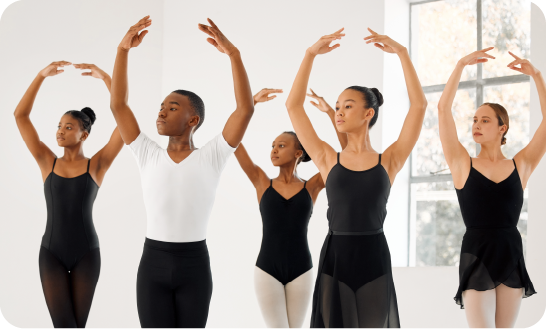How to Correct Your Posture
The phrases ‘sit up’ or ‘do not slouch’ are frequently heard from parents and teachers hoping to set a precedent for good posture. Despite being an unpopular instruction, correct posture is crucial in developing healthy spines and facilitating full movement functionality. Indeed, questions concerning what correct posture is and how to develop it still dominate fitness forums today.
How Do you Develop Good Posture?
To the dismay of many gadget collectors, correct posture is not a commodity and cannot be bought. Fortunately, correct posture can be learnt and over time, strengthened. PBT’s Backalast provides dancers and non-dancers with a comprehensive solution to their posture problems, facilitating correct alignment through its supportive and stylish design.
What is Correct Posture?

Posture refers to the way we carry our bodies both when stationary (static posture) and when moving (dynamic posture). A person’s posture is determined by connections between their skin, muscles, bone, tendons, ligaments and joints, also known as their musculoskeletal system. Whilst bad posture can make an individual appear less confident, its aesthetic function is not the main concern for physios and dance teachers. In fact, a recent study published in the Journal of Physical Therapy Science concluded that good posture has the potential to significantly reduce neck and back pain in individuals.
Bad alignment and bad posture is a large contributing factor to injuries both inside and outside of the studio.
In addition to dancers, it is common to hear of office workers struggling with neck or back pain. Their aches can easily be traced back to a common culprit: bad posture. Whether hunched over a laptop or slouched in front of the TV, good posture is often neglected for the sake of comfort. The cruel irony is that failure to correct posture early on can significantly exacerbate later discomforts. Sadly, in the ballet community, as much as the outside world, good posture has an ugly and fictitious reputation for being unattainable. In truth, correct posture begins with addressing the positioning of the spine and the muscles that surround it, positions that have been formed and aggravated by years of unhealthy habits.
Why is Good Posture Important in Ballet?
Ballet has long been synonymous with good posture and many adults take dance classes recreationally for precisely that reason. Activating the muscles and elongating the spine in an effort to establish good posture can help to relieve individuals of tightness and sore muscles.
Prevention is often thought to be better than cure. In the case of aches and pains, good posture is a very powerful prevention tool.
However, the importance of posture in dance extends far beyond any aesthetic prowess or pain relief. Posture is in fact the foundation for many more complex movements. Turns, jumps, and even adagio all require the dancer's bones and muscles to be placed in a way that facilitates abnormal motions. If their posture is skewed and their muscles imbalanced, dancers risk putting excessive strain through their joints, leading to weakness, pain and all too frequently, injury.
Is Ballet Training Enough to Develop Good Posture?

Ballet technique itself is designed to develop good posture. Movement sequences such as port de bras (carriage of the arms) are an integral feature of classical ballet. In addition to developing coordination and soft arm movements, port de bras serves to enhance good posture, strengthening the dancer’s back and aligning their scapulae. Whilst exercises such as port de bras can improve a dancer’s kinaesthesia and thus ability to implement good posture, without supplementary training, its impact is significantly limited.
In the studio, under the watchful eye of their teacher, dancers may be able to sustain good posture. However, once the dancer leaves the studio, efforts to implement good posture are forced to contend with the age of slouched shoulder mobile phone holders and hunched back rucksack wearers. Bad posture habits may also be exacerbated during cross training or supplementary workouts as the dancer no longer has their teacher to advise on good posture. As a result their endeavours to strengthen may be jeopardised and could even result in intensifying existing pains.
Fortunately, just as one can learn bad posture and habitually aggravate it, likewise, they can unlearn bad posture.
Using the Backalast to Develop Good Posture

Acknowledgement is the first step to recovery and recovering from bad posture is no different. However, implementing impactful change and developing good posture can be a difficult task, particularly when fighting against years of unconscious practices. Adopting the teacher role and self-correcting bad posture is definitely a possibility. Yet, with no feedback or metric to measure improvement, this method can be challenging to sustain. In order to achieve good posture, individuals need consistent, supportive and effective means.
PBT’s Backalast is a simple and sustainable answer to developing good posture.
Expertly crafted to strengthen the thoracic spine, the Backalast’s elastic panel and invisible mesh layers provide a supportive and stylish solution to postural problems. Whether worn in ballet class or out and about, the Backalast provides valuable feedback on spinal imbalances, enhancing the user’s awareness of their scapulae and facilitating the correct alignment of the head, neck and shoulders to ensure good posture. Its breathable compression fabric makes it perfect for everyday wear, encouraging technique correction and good posture beyond the classroom. Suitable for non dancers and dancers alike, the Backalast is a simple and effective method of enacting impactful change and finally understanding and developing good posture.
订阅PBT资讯
接收小贴士、新闻、建议.